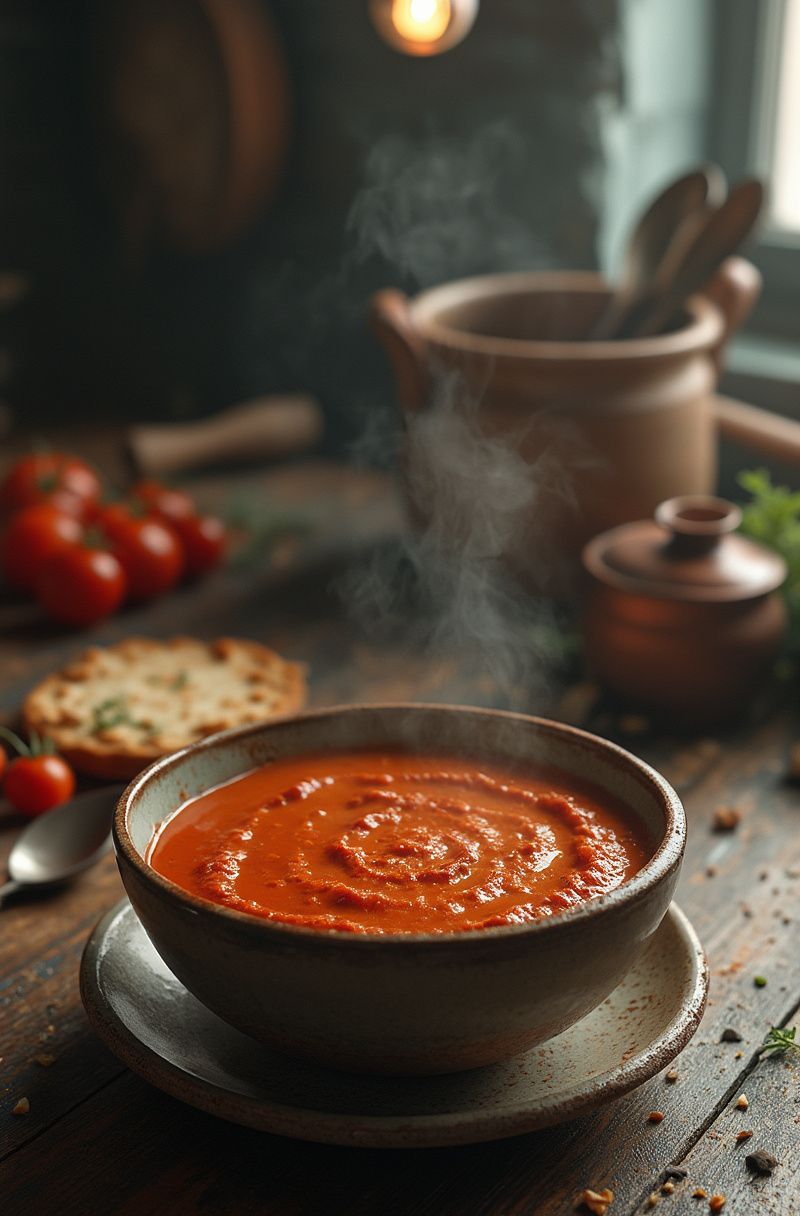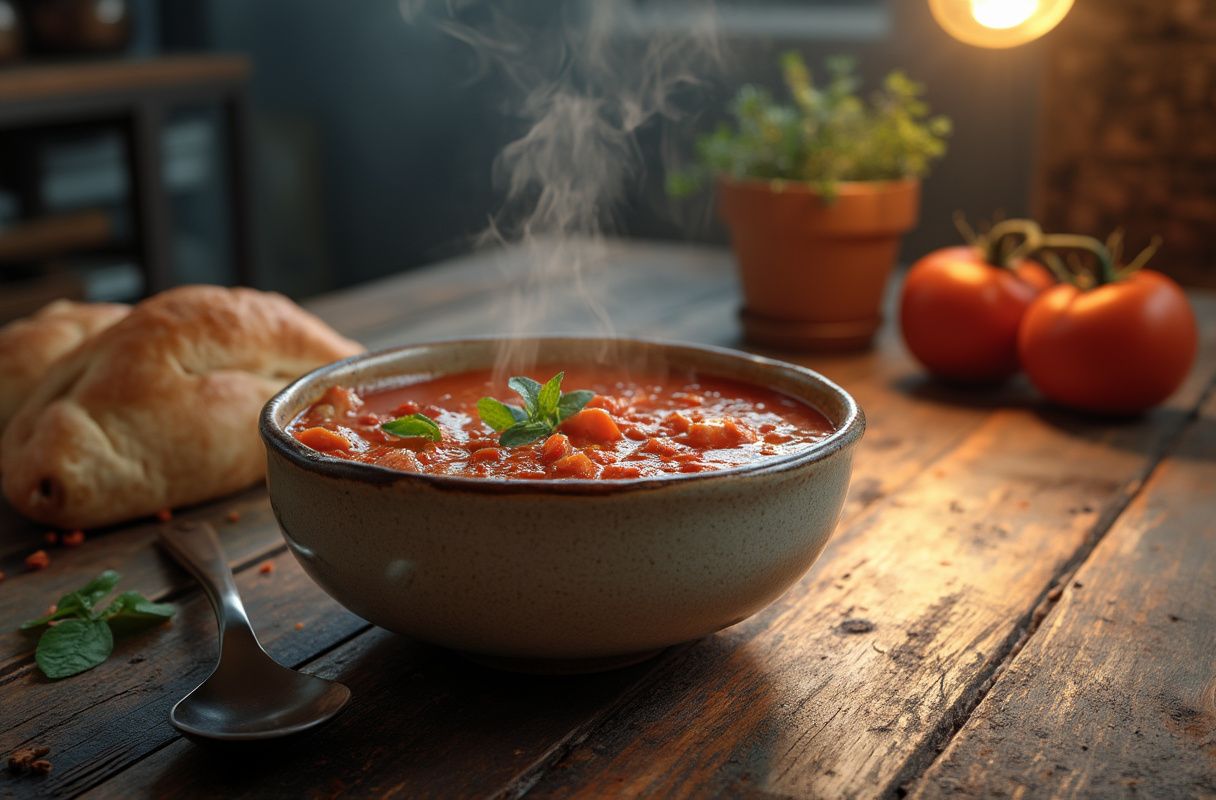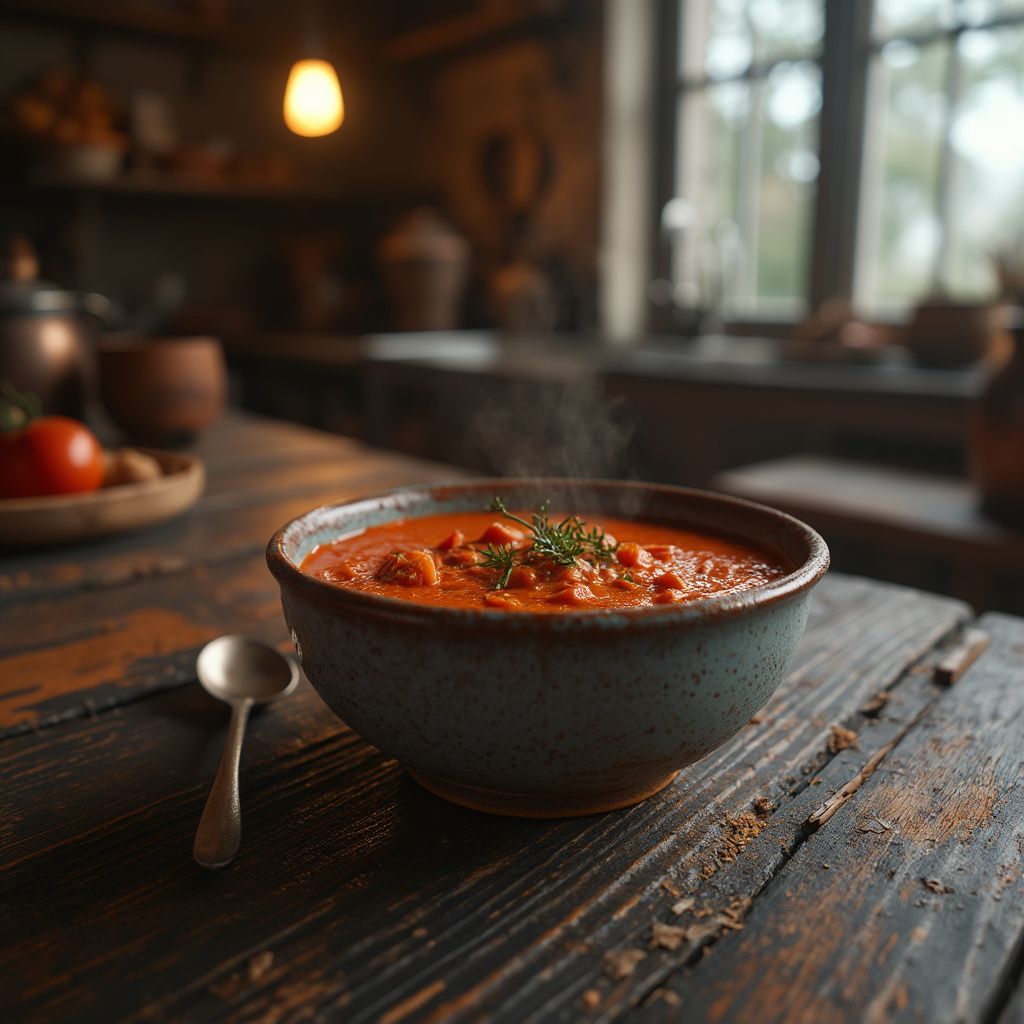Roasted tomato soup is a heartwarming dish that transcends seasons, offering comfort and a burst of flavor with every sip. This recipe is a celebration of ripe tomatoes, their natural sweetness and acidity concentrated through roasting, and then blended into a silky, aromatic soup that feels like a warm hug on a chilly day. The process of roasting elevates the humble tomato to a whole new level, making it both a simple yet sophisticated dish suitable for any occasion.
Origins and Evolution
The origins of tomato soup can be traced back to the late 19th century, though the use of tomatoes in soups has a much richer history. Tomatoes, native to western South America, were brought to Europe by Spanish explorers in the 16th century. Initially met with suspicion due to their resemblance to the toxic nightshade plant, tomatoes gradually gained popularity and eventually established themselves as a staple in Mediterranean cuisines. It wasn’t until the arrival of tomatoes in North America that they truly found their place in soups.
The first recorded recipe for tomato soup emerged in the United States, with the Campbell Soup Company famously introducing condensed tomato soup in 1897. This innovation made tomato soup a household staple, beloved for its convenience and comforting qualities. Over the decades, the recipe has evolved, with roasted tomato soup becoming a modern favorite. Roasting tomatoes enhances their flavor, offering a deeper, more complex taste that reflects a growing appreciation for culinary depth and simplicity.
Unique Ingredients and Flavor Profiles

Roasted tomato soup stands out due to its minimal yet impactful list of ingredients. The star of the show is, of course, the tomato. For this recipe, vine-ripened tomatoes or Roma tomatoes are preferred for their rich flavor and lower moisture content, which helps concentrate their taste when roasted. Alongside tomatoes, garlic and onions are roasted to add a savory depth and sweetness, while fresh basil infuses the soup with a fragrant, herbal note that complements the acidity of the tomatoes beautifully.
Roasting the vegetables is a crucial step that cannot be overstated. It’s like giving the ingredients a sun-kissed glow, caramelizing their natural sugars and intensifying their flavors. As the tomatoes blister and the garlic softens, a transformation occurs, turning these raw ingredients into a tantalizing base for the soup. A touch of olive oil, a dash of salt and pepper, and a sprinkle of sugar (to balance the acidity) are all it takes to coax out the best from these ingredients.
Techniques and Tips
The art of making a great roasted tomato soup lies in the technique. Roasting is key, and it’s essential to spread the tomatoes, garlic, and onions evenly on a baking sheet to ensure they cook uniformly. Don’t rush the roasting process; let the oven work its magic until the tomatoes are slightly charred and the onions are tender. This step imparts a smoky, sweet flavor that forms the backbone of the soup.
After roasting, the ingredients are blended into a smooth puree. A high-speed blender or immersion blender works best for achieving a velvety texture. At this stage, incorporating a splash of vegetable or chicken stock adds a layer of complexity, while a swirl of cream can be added for those who prefer a richer finish. Seasoning is crucial, so taste and adjust with salt, pepper, and perhaps a pinch of cayenne for a subtle kick.
Cultural Significance

Roasted tomato soup, with its humble origins and simple preparation, resonates across cultures and generations. It’s a dish that embodies the essence of comfort food, evoking nostalgia and warmth. From the kitchens of Italy to the tables of America, this soup has become a beloved staple, appreciated for its ability to bring people together around the table, sharing stories and laughter over a bowl of goodness.
In many cultures, soup is more than just a meal; it’s a ritual, a way of life. Whether enjoyed as a starter, a main course, or a pick-me-up on a cold day, roasted tomato soup is a testament to the enduring appeal of classic flavors and the timeless art of cooking. It’s a dish that invites creativity, allowing cooks to put their spin on a traditional favorite, ensuring its place in the culinary landscape for years to come.
Rustic Roasted Tomato Soup
Description
Experience the rich, smoky flavor of oven-roasted tomatoes, blended to creamy perfection. This soup is a delightful marriage of simplicity and depth, perfect for any occasion.
Ingredients
For the Roasted Tomatoes
For the Soup Base
Instructions
Preparing the Ingredients
-
Select and Prepare Your Tomatoes
Choose about 2 pounds of ripe, juicy tomatoes. Rinse them well under cold water, then slice each tomato in half. Lay them cut-side up on a large baking sheet.Opt for tomatoes at their peak ripeness for the best flavor. If you can, try using a mix of varieties for a deeper, more complex taste. -
Prepare the Aromatics
Peel and quarter a large onion, and peel 4 cloves of garlic. Scatter these among the tomatoes on the baking sheet.Don't worry if the garlic cloves are large—roasting mellows their flavor beautifully.
Roasting for Depth
-
Roast the Vegetables
Preheat your oven to 400°F (200°C). Drizzle the tomatoes, garlic, and onion with olive oil, then sprinkle generously with salt and a pinch of black pepper. Roast in the oven for about 45 minutes, until the tomatoes are slightly charred and the onions are caramelized.Roasting intensifies the natural sweetness of the tomatoes and garlic, adding a savory depth to your soup. Don’t skip this step—it’s magic!
Blending and Cooking
-
Blend Until Smooth
Once roasted, transfer the tomatoes, onions, and garlic to a blender. Add a handful of fresh basil leaves and blend until you have a smooth, velvety texture.If you prefer a chunkier texture, pulse the blender a few times instead of blending continuously. -
Simmer the Soup
Pour the blended mixture into a large pot over medium heat. Add 2 cups of vegetable broth, stirring to combine. Bring the soup to a gentle simmer and let it cook for about 10 minutes to meld the flavors.Feel free to adjust the consistency of the soup by adding more broth if you like it thinner.
Finishing Touches
-
Season to Taste
Taste the soup and adjust the seasoning with more salt and pepper if needed. For a touch of heat, add a pinch of red pepper flakes.A final splash of balsamic vinegar can add a delightful tanginess to balance the sweetness of the tomatoes. -
Serve and Enjoy
Ladle the soup into bowls and garnish with a swirl of cream or a sprinkle of parmesan cheese if desired. Serve hot with crusty bread on the side.For a vegan version, omit the cream or cheese and perhaps top with a dollop of pesto for an extra burst of flavor.
Note
- Opt for ripe, juicy tomatoes for the richest flavor. Roma or plum tomatoes are excellent choices due to their dense flesh.
- Roasting the tomatoes, onions, and garlic adds a depth of flavor—you'll want them slightly caramelized for that sweet, smoky undertone.
- If you like a bit of heat, try adding a pinch of red pepper flakes when roasting the vegetables.
- For a creamy texture without adding cream, consider blending in a handful of soaked cashews or using full-fat coconut milk.
- Use homemade vegetable or chicken stock for the best flavor, but store-bought is fine in a pinch.
- To intensify the soup's richness, deglaze the roasting pan with a splash of white wine or balsamic vinegar and add it to the soup.
- Don’t skip the step of straining the soup if you prefer a velvety smooth finish.
- Fresh basil or thyme makes for a perfect garnish—tear the leaves right before serving to release their oils.
- Store leftovers in an airtight container in the refrigerator for up to 3 days. It also freezes well for up to 3 months.
- Serve with crusty bread or a classic grilled cheese sandwich for a comforting meal.







